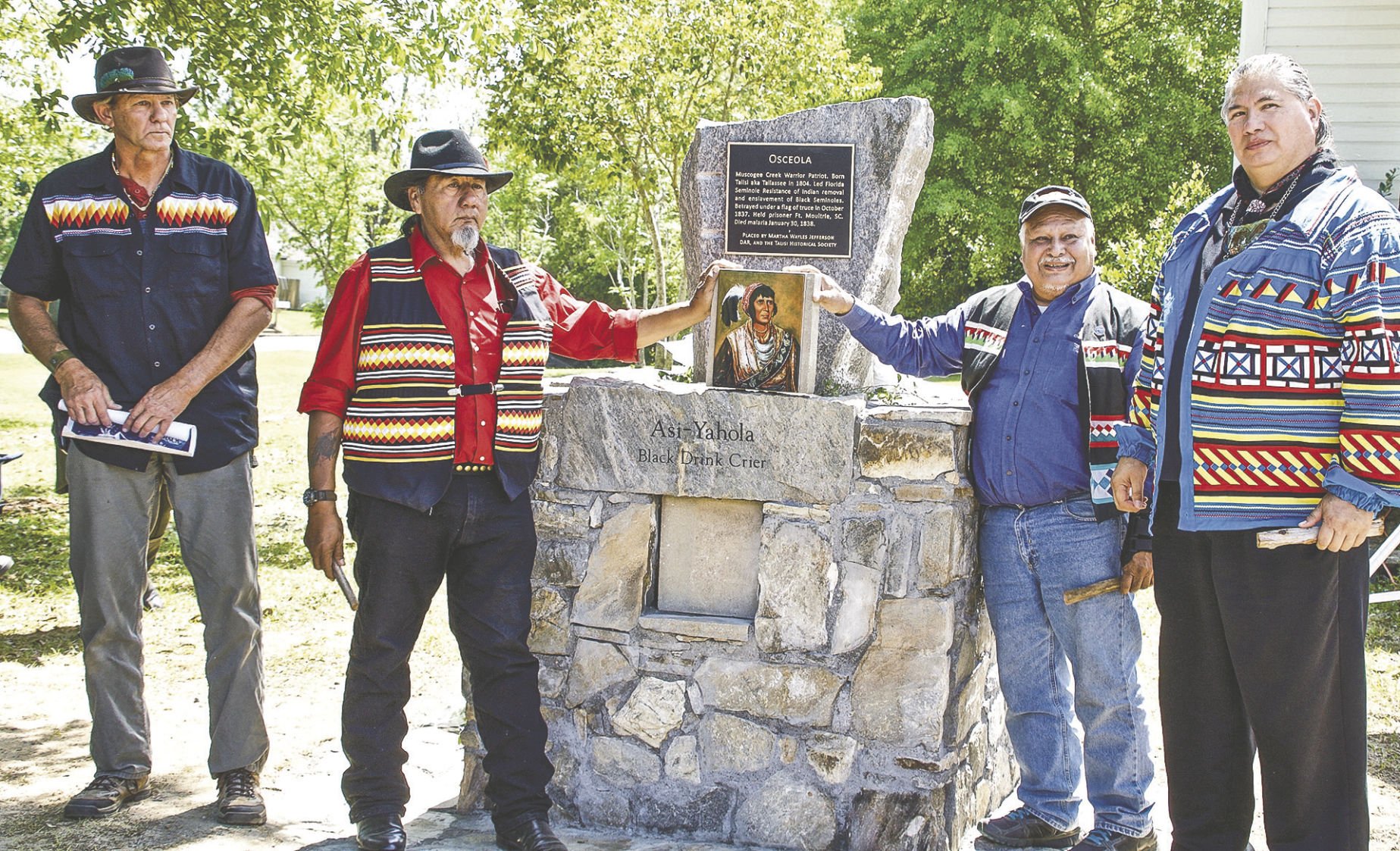By Carmen Rodgers
Staff writer
The Talisi Historical Society and the Daughters of the American Revolution out of Opelika held the official unveiling of the Osceola Monument on Saturday. The monument is located on the grounds of the Superintendent’s House, which is adjacent to Tallassee’s City Hall.
Local artist Charles Chambers created the monument. When Chambers isn’t busy building monuments and creating masterpieces, he serves as the fire chief at the Red Hill Fire Department. According to Chambers, he had help constructing this monument. Cheyanne Chambers, Judah Chambers, Frankie and Molly Tatum, Gabriel Ashford, Wesley and Henley Brown, Gavin Brown, Steve Travis, Timothy Osborne, James Oliver and Brian Dennis all helped in building the monument, which was constructed using stone from the 1844 Tallassee Mill Site. Paul Wright, Brandon Wright and Bobby Hughes, with W&W Monuments, also assisted with the monument’s erection.
Chambers got involved in the project late in April and worked tirelessly to bring the monument to fruition.
“We were so pleased when Charles stepped forward to help with this monument,” said Bill Goss, master of ceremonies for the unveiling and historian for Talisi Historical Society and Talisi Falls Museum. “He did it because he is a good man.”
While constructing the monument Chambers noticed unusual marking on the stone slab.
“These lines here, lines like this occur naturally but they should be in the same direction,” said Chambers. “These lines cross each other.”
Chambers only noticed these lines by chance.
“The lines are not that noticeable unless the stone is wet,” he said. “I was here working on it one day when it started raining. That’s when I noticed the lines.”
The stone monument stands roughly six feet tall. At the top of the monument sits the stone with the unique cross pattern marks. A bronze plaque commemorating Osceola is attached to the stone and below it a photo of Osceola is inset in the monument’s stonework.
Martha Wayles Jefferson with the Opelika DAR Chapter donated the plaque and Linda Shabo designed it.
Charlie Billie, a direct descendant of Osceola with the Seminole Tribe of Florida, attended Saturday’s unveiling. Billie encouraged everyone to reach out with an elder because they are “living history”.
Lewis Johnson with the Seminole Nation of Oklahoma, also made the trip to Tallassee to honor Osceola.
“It takes all these functions to keep our history alive,” said Johnson. “I have been here many times, to Wetumpka and this area. It is an honor and I am humbled to be here today. We always have a certain feeling that swells inside of us as we walk in these areas around the rivers and some of the sites we see from time to time. We know what it is. We know it’s the spirit of our ancestors and how they still speak to us in spiritual way.”
Johnson is also member of the Bird Clan and the Tallahassee Band. He explained the connection between Tallahassee and Tallassee.
“Tallahassee is a derivative of the folks who lived in this area and I have been told since I was a child that Osceola had close relations or came directly from our particular band. When you think about Osceola we think about how he was thrown into the conflicts of that day. As I woke up this morning, I looked out of the window and saw the sun coming up. Our hotel room was facing undeveloped area. … It was beautiful.”
Ted Isham with the Muscogee Creek Seminole Nation also attended Saturday’s unveiling. Isham is an expert in Native American linguistics and he explained why the local location markers have a deeper meaning for many.
“Because we have such a connection to our homelands, all of the place names that we see here mean something to us, even today” Isham said.
Isham explained Osceola’s transition from Creek to Seminole, which is largely still a mystery.
“Osceola came from Talisi and moved down because of strife to the Seminoles. He woke up one day changed from Creek to Seminole. I’m not sure how that worked, but he was moving on up,” Isham said with laughter. “We have this kidding around of the two nations, between the Creeks and the Seminoles. That side of the history is rich for us because we venerate this person.”
Tallassee has a deep Native American history. The name Tallassee, or Talisi, means “old town”. The name itself suggests antiquity. The historic Creek people in this area are believed to have descended from the Mississippian culture, which flourished throughout the Mississippi and Ohio River valleys and the Southeast from about 1000 to 1450. They were mound builders that created massive earthwork mounds as structures for political and religious purposes. They relied greatly on fishing and river way trading at their major sites.
Talisi was a town of the Coosa Province of the Mississippian culture; it was visited in 1540 by Hernando de Soto and his expedition through the Southeast. Later the historic Creek people occupied it. The Tallassee area was the location of the Creek capital city, Tuckabatchee, as well as the location of the seven sacred plates.
Tensions first broke out as a civil war among the Creek, but US forces also got involved. Trying to intercept a Red Stick party who were bringing back arms thought to be purchased from the Spanish in Florida, United States Army forces attacked the Creek at the Battle of Burnt Corn. The Creek band ultimately defeated the soldiers. In retaliation, the next month the Red Sticks attacked Fort Mims, about 35 miles north of Mobile, killing most of the more than 500 settlers and mixed-race Lower Creek who had taken refuge there.
Osceola is believed to have been born in Talisi near the Euphabee Creek, to a mixed-race Creek mother and an English father. He was among those Creek who migrated to Florida after the Creek War and joined the Seminole Indians. He became a prominent leader who continued resistance to US forces and settlement.


